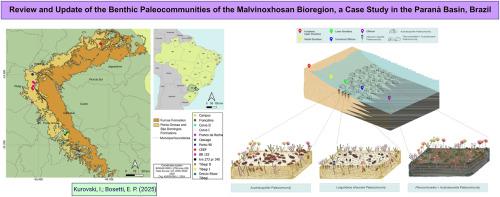Malvinoxhosan生物区底栖生物群落回顾与更新——以巴西paran盆地为例
IF 1.5
4区 地球科学
Q3 GEOSCIENCES, MULTIDISCIPLINARY
引用次数: 0
摘要
1971年,Arthur James Boucot提出了第一个泥盆纪海洋底栖无脊椎动物的古群落:Lingula, Australospirifer, Eocoelia和Notichonetes。但是,由于埋藏法在当时还没有得到广泛应用,所以有些方面没有考虑到。这项工作的目的是修正这些古群落,考虑到这些因素。根据野外观测、实验室样品分析和文献综述,提出了以下古群落:a)“Australospirifer”;b)“Infaunal Lingulids”(在对Lingula进行分类学修订之前的临时名称);c)“盘球虫+ Australocoelia”。它们位于以下古环境设置中:Lower Shoreface(前两个)和Lower Shoreface to Offshore Transition(最后一个)。这些变化是合理的:(1)Australospirifer古群落被保留下来,因为它是在野外和实验室中发现的,除了一些以前被解释为原位的运输材料。(2)所谓Lingula古群落是一个死亡群落,Lingula属已不再被认为是古生代,不适合作为代表分类单元。(3)微球藻和微球藻的古群落可能是一个单独的类群,因为它们经常出现在同一古环境中,有时也出现在生活位置。Boucot的古群落是帕拉南本文章由计算机程序翻译,如有差异,请以英文原文为准。

Review and update of the benthic paleocommunities of the Malvinoxhosan Bioregion, a case study in the Paraná Basin, Brazil
In 1971, Arthur James Boucot proposed the first paleocommunities for Devonian benthic marine invertebrates of the Malvinokaffric Realm: Lingula, Australospirifer, Eocoelia, and Notichonetes. However, since taphonomy was not widely applied at the time, some aspects were not considered. This work aims to revise these paleocommunities, taking those factors into account. Based on field observations, laboratory sample analysis, and literature review, the following paleocommunities are proposed: a) “Australospirifer”; b) “Infaunal Lingulids” (a provisional name until a taxonomic revision of Lingula is conducted); and c) “Pleurochonetes + Australocoelia”. These are positioned within the following paleoenvironmental settings: Lower Shoreface (first two) and Lower Shoreface to Offshore Transition (last one). These changes are justified by: (1) The Australospirifer Paleocommunity is retained, as it was identified both in the field and laboratory, except for some transported material previously interpreted as in situ. (2) The so-called Lingula paleocommunity is a thanatocoenosis, and the genus Lingula is no longer considered Paleozoic, making it unsuitable as a representative taxon. (3) The Eocoelia and Notichonetes paleocommunities may represent a single group, as they are often found together in the same paleoenvironment and sometimes in life position. Boucot's paleocommunities are a reference for the Devonian of the Paraná Basin but require updates due to numerous recent discoveries and the integration of new fields such as taphonomy and ichnology. Therefore, this work presents an updated arrangement of the Devonian paleocommunities in the Paraná Basin, based on field evidence and recent studies.
求助全文
通过发布文献求助,成功后即可免费获取论文全文。
去求助
来源期刊

Journal of South American Earth Sciences
地学-地球科学综合
CiteScore
3.70
自引率
22.20%
发文量
364
审稿时长
6-12 weeks
期刊介绍:
Papers must have a regional appeal and should present work of more than local significance. Research papers dealing with the regional geology of South American cratons and mobile belts, within the following research fields:
-Economic geology, metallogenesis and hydrocarbon genesis and reservoirs.
-Geophysics, geochemistry, volcanology, igneous and metamorphic petrology.
-Tectonics, neo- and seismotectonics and geodynamic modeling.
-Geomorphology, geological hazards, environmental geology, climate change in America and Antarctica, and soil research.
-Stratigraphy, sedimentology, structure and basin evolution.
-Paleontology, paleoecology, paleoclimatology and Quaternary geology.
New developments in already established regional projects and new initiatives dealing with the geology of the continent will be summarized and presented on a regular basis. Short notes, discussions, book reviews and conference and workshop reports will also be included when relevant.
 求助内容:
求助内容: 应助结果提醒方式:
应助结果提醒方式:


